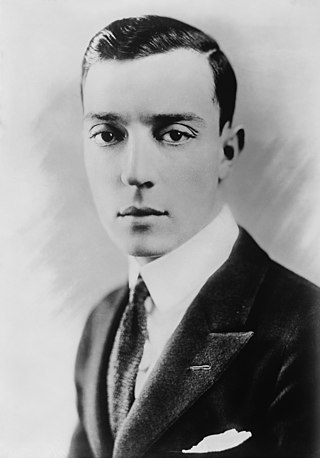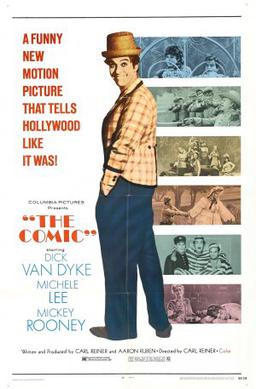
Comedy film is a film genre that emphasizes humor. These films are designed to amuse audiences and make them laugh. Films in this genre typically have a happy ending, with dark comedy being an exception to this rule. Comedy is one of the oldest genres in film, and it is derived from classical comedy in theatre. Some of the earliest silent films were slapstick comedies, which often relied on visual depictions, such as sight gags and pratfalls, so they could be enjoyed without requiring sound. To provide drama and excitement to silent movies, live music was played in sync with the action on the screen, on pianos, organs, and other instruments. When sound films became more prevalent during the 1920s, comedy films grew in popularity, as laughter could result from both burlesque situations but also from humorous dialogue.

The Keystone Cops are fictional, humorously incompetent policemen featured in silent film slapstick comedies produced by Mack Sennett for his Keystone Film Company between 1912 and 1917.

Slapstick is a style of humor involving exaggerated physical activity that exceeds the boundaries of normal physical comedy. Slapstick may involve both intentional violence and violence by mishap, often resulting from inept use of props such as saws and ladders.

Joseph Frank "Buster" Keaton was an American actor, comedian and film director. He is best known for his silent films during the 1920s, in which he performed physical comedy and inventive stunts. He frequently maintained a stoic, deadpan facial expression that became his trademark and earned him the nickname "The Great Stone Face".

The Great Dictator is a 1940 American anti-war, political satire, and black comedy film written, directed, produced, scored by, and starring British comedian Charlie Chaplin, following the tradition of many of his other films. Having been the only Hollywood filmmaker to continue to make silent films well into the period of sound films, Chaplin made this his first true sound film.
In film, television, and radio, British comedy has produced some of the most renowned characters in the world. In it, satire is one of the features of Biritsh comedy. Radio comedy in Britain has been almost exclusively hosted on BBC.

Harold Clayton Lloyd Sr. was an American actor, comedian, and stunt performer who appeared in many silent comedy films.

A comedian or comic is a person who seeks to entertain an audience by making them laugh. This might be through jokes or amusing situations, or acting foolishly, or employing prop comedy. A comedian who addresses an audience directly is called a stand-up comedian.

Isaac Sidney Caesar was an American actor, comedian and writer. With a career spanning 60 years, he was best known for two pioneering 1950s live television series: Your Show of Shows (1950–1954), which was a 90-minute weekly show watched by 60 million people, and its successor, Caesar's Hour (1954–1957), both of which influenced later generations of comedians. Your Show of Shows and its cast received seven Emmy nominations between the years 1953 and 1954 and tallied two wins. He also acted in films; he played Coach Calhoun in Grease (1978) and its sequel Grease 2 (1982) and appeared in the films It's a Mad, Mad, Mad, Mad World (1963), Silent Movie (1976), History of the World, Part I (1981), Cannonball Run II (1984), and Vegas Vacation (1997).

Charles Joseph Parrott, known professionally as Charley Chase, was an American comedian, actor, screenwriter and film director. He worked for many pioneering comedy studios but is chiefly associated with producer Hal Roach. Chase was the elder brother of comedian/director James Parrott.

Silent Movie is a 1976 American satirical silent comedy film co-written, directed by and starring Mel Brooks, released by 20th Century Fox in summer 1976. The ensemble cast includes Dom DeLuise, Marty Feldman, Bernadette Peters. and Sid Caesar, with cameos by Anne Bancroft, Liza Minnelli, Burt Reynolds, James Caan, Marcel Marceau, and Paul Newman as themselves, and character cameos by Harry Ritz of the Ritz Brothers, Charlie Callas, and Henny Youngman. The film was produced in the manner of an early-20th-century silent film, with intertitles instead of spoken dialogue; the soundtrack consists almost entirely of orchestral accompaniment and sound effects. It is an affectionate parody of slapstick comedies, including those of Charlie Chaplin, Mack Sennett, and Buster Keaton. The film satirizes the film industry, presenting the story of a film producer trying to obtain studio support to make a silent film in the 1970s.
Radio comedy, or comedic radio programming, is a radio broadcast that may involve variety show, sitcom elements, sketches, and various types of comedy found in other media. It may also include more surreal or fantastic elements, as these can be conveyed on a small budget with just a few sound effects or some simple dialogue. Radio comedy began in the United States in 1930, based on the fact that as most United Kingdom music hall comedians such as Charlie Chaplin and Stan Laurel progressed to silent films, they moved to Hollywood and fed the radio comedy field. Another British music hall comic, George Formby, stayed in the British movie industry, and in 1940 joined the Entertainments National Service Association to entertain British World War II troops. UK radio comedy therefore started later, in the 1950s.

A double act is a form of comedy originating in the British music hall tradition, and American vaudeville, in which two comedians perform together as a single act, often highlighting differences in their characters' personalities. Pairings are typically long-term, in some cases for the artists' entire careers. Double acts perform on the stage, television and film.

Silent comedy is a style of film, related to but distinct from mime, invented to bring comedy into the medium of film in the silent film era (1900s–1920s) before a synchronized soundtrack which could include talking was technologically available for the majority of films. Silent comedy is still practiced, albeit much less frequently, and it has influenced comedy in modern media as well.

Henry "Harry" Philmore Langdon was an American comedian who appeared in vaudeville, silent films, and talkies.

Funny Business, also known as Laughing Matters, is a BBC television documentary series about the craft of comedy. Originally airing in the UK on 22 November 1992, the series consisted of six 50-minute episodes with each one focusing on a different aspect of humour and show business entertainment. The series producer was Sarah Williams and was produced by Tiger Aspect Productions for the BBC. The series was also broadcast in Germany and New Zealand and later released on video.

The Comic is a 1969 American Pathécolor comedy-drama film co-written, co-produced, and directed by Carl Reiner. It stars Dick Van Dyke as Billy Bright, Michele Lee as Bright's love interest, and Reiner himself and Mickey Rooney as Bright's friends and colleagues. Reiner wrote the screenplay with Aaron Ruben; it was inspired by the end of silent film era and, in part, by the life of silent film superstar Buster Keaton.

Comedy is a genre of fiction that consists of discourses or works intended to be humorous or amusing by inducing laughter, especially in theatre, film, stand-up comedy, television, radio, books, or any other entertainment medium. The term originated in ancient Greece: In Athenian democracy, the public opinion of voters was influenced by political satire performed by comic poets in theaters. The theatrical genre of Greek comedy can be described as a dramatic performance pitting two groups, ages, genders, or societies against each other in an amusing agon or conflict. Northrop Frye depicted these two opposing sides as a "Society of Youth" and a "Society of the Old". A revised view characterizes the essential agon of comedy as a struggle between a relatively powerless youth and the societal conventions posing obstacles to his hopes. In this struggle, the youth then becomes constrained by his lack of social authority, and is left with little choice but to resort to ruses which engender dramatic irony, which provokes laughter.

Hollywood Cavalcade is a 1939 American film featuring Alice Faye as a young performer making her way in the early days of Hollywood, from slapstick silent pictures through the transition from silent to sound.
French comedy films are comedy films produced in France. Comedy is the most popular French genre in cinema.


















